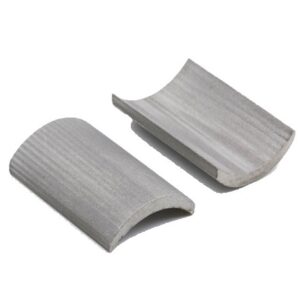Laminated magnets are magnetic assemblies made by layering thin sheets of magnetic material, typically with insulation between the layers. This lamination helps reduce eddy current losses that occur when magnets are subjected to rapidly changing magnetic fields. Eddy currents generate heat and energy losses, which can reduce the efficiency of magnetic systems, especially in high-speed electric motors, generators, and transformers.
Purpose:
The lamination minimizes energy loss due to eddy currents, improving performance in applications where magnets are exposed to fluctuating magnetic fields.
Materials:
Common materials used in laminated magnets include neodymium (NdFeB) or ferrite magnets, with insulation layers like glue, epoxy, polyester, or other non-conductive materials between the sheets.


Here are the specific advantages and applications of laminated magnets:
Advantages of Laminated Magnets 
- Reduced Eddy Current Losses: Eddy currents are induced when magnets are exposed to varying magnetic fields, especially in high-speed motors and other dynamic systems. These currents create heat and energy losses. Laminated magnets reduce the surface area for eddy currents to form, minimizing these losses and improving overall system efficiency.
- Improved Efficiency in High-Speed Systems: Laminated magnets are ideal for systems that operate at high speeds or have rapidly changing magnetic fields. By reducing energy losses, they help increase the output efficiency of motors, generators, and transformers.
- Reduced Heat Generation: By minimizing eddy currents, laminated magnets also reduce heat generation. This leads to less energy being wasted as heat, which can prolong the life of the system and reduce the need for cooling solutions.
- Increased Durability: Laminated magnets are more resistant to the thermal stresses that can occur in systems with high heat loads. This makes them more durable and capable of withstanding the harsh conditions of industrial applications.
- Better Magnetic Performance: Because eddy currents are minimized, laminated magnets maintain stronger magnetic performance, leading to more consistent power output over time in motors and other devices.
- Cost-Effective Over Time: While laminated magnets may have a higher upfront cost due to the manufacturing process, they offer long-term cost savings by reducing energy losses and increasing the durability and lifespan of equipment.
 Applications of Laminated Magnets
Applications of Laminated Magnets
- High-Efficiency Electric Motors: Laminated magnets are frequently used in high-performance electric motors, such as those found in electric vehicles (EVs), drones, and industrial machinery. These motors require high efficiency, low heat generation, and consistent magnetic performance at varying speeds.
- Generators: Generators, especially in wind turbines or other renewable energy systems, benefit from laminated magnets due to their ability to operate efficiently with minimal energy loss over time, even at high speeds.
- Transformers: In transformers, laminated magnets help reduce core losses, leading to better energy efficiency in power transmission systems.
- Inductive Sensors and Actuators: Laminated magnets are also used in devices like sensors and actuators that rely on precise magnetic field control. The reduced eddy currents help maintain accuracy in measurements and actuation.
- Magnetic Couplings: Magnetic couplings, which transfer torque between systems without physical contact, also use laminated magnets to ensure efficient operation in dynamic environments.
- Magnetic Bearings: In magnetic bearing systems, where magnets are used to levitate and support moving components, laminated magnets provide smoother operation and reduced friction, leading to less wear and tear on the system.
Industries Where Laminated Magnets are Common:
- Automotive: Electric vehicles and hybrid cars.
- Aerospace: Drones, satellites, and high-speed systems.
- Industrial Machinery: Motors and actuators used in automation and manufacturing.
- Renewable Energy: Wind turbines and other energy generation systems.
- These benefits make laminated magnets particularly valuable in cutting-edge applications that demand high performance, efficiency, and longevity.




 Applications of Laminated Magnets
Applications of Laminated Magnets